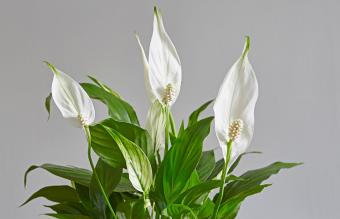
Peace lily (Spathiphyllum) is an easy-to-grow plant that grows well even in low light. It looks wonderful placed on a shelf, table, or in a plant stand. If given enough light, peace lilies (not actually a member of the lily family at all) will send up white or pink blooms that somewhat resemble lilies. They can take a bit of neglect and provide plenty of beauty and air-purifying in return.
How to Grow Peace Lily
Overall, peace lilies are easy to grow, and peace lily care is fairly minimal. The thing they are fussiest about is water, but once you get a feel for when to water, caring for your peace lily will be straightforward.
Light
Peace lily grows best in bright indirect to medium light, and will even grow fairly well in low light, though it will not bloom in low light conditions. This plant is happy anywhere other than in direct sun, where the leaves can become sunburned and the soil tends to dry out much more quickly.

Water
Peace lily really does not like to dry out. Once the soil gets too dry, the plant starts throwing the plant equivalent of a temper tantrum, its leaves going dramatically droopy until you give it a nice, deep watering. If that happens too many times, it will weaken the plant and the peace lily will take a bit longer to bounce back from its droopiness.
- Keep the soil of peace lilies evenly moist, but not soggy (soggy soil causes root rot, which kills plants).
- The best way to determine whether peace lily needs to be watered is to stick your fingertip into the soil. If the top inch of soil is dry, water well and let the excess water drain.
Temperature and Humidity
Peace lilies grow well in average home temperatures, away from cold windows or drafts.
They thrive in higher humidity, so you might want to try one of these ways to provide it:
- Lightly mist the air around the plants once or twice per day.
- Install a humidifier in the room where your peace lily is growing.
- Place the peace lily's pot on a tray filled with pebbles and water.
Fertilizing
Peace lily is not a heavy feeder, and excess fertilizer can sometimes cause the tips of the leaves to turn brown or yellow.
- Feed monthly with a balanced houseplant fertilizer during the spring and summer.
- Peace lilies don't need fertilizing during the winter.
Soil
Any well-draining general potting mix will work for peace lilies.
Repotting
Peace lilies actually prefer being a bit pot-bound, so they can go longer between repottings than some other houseplants. However, if you notice the plant drying out excessively quickly, or roots trying to escape through the drainage holes, it's time to pot up to the next size container.
Transplant the peace lily as deeply in the new pot as it was growing in its former container.
Peace Lily Pests and Problems
Peace lilies aren't prone to many pests, diseases or problems, but there are a few things to look out for.
Mealybugs
Mealybugs are small oval insects that have a waxy coating that give them an almost fuzzy appearance. They suck the sap from the green stems of houseplants, weakening it and sometimes transferring diseases.
To get rid of mealybugs, either wash them away with a strong spray of water from a sprayer or your showerhead, or get some rubbing alcohol on a soft cotton pad or cloth and wipe your plant stems with it. The alcohol will kill the mealybugs, and you'll wipe them off of your plant in the process.
Yellowing Leaves
Yellowing leaves are a sign of improper watering. They can either be caused by too little water, or too much water. The only way to be sure is to stick your finger into the potting mix. If it's very wet, you know the problem is too much water, and to water less often. If the potting mix is dry, you will need to water more often.
Occasionally, very old leaves will turn yellow, then brown. This has nothing to do with water, and is more about the age of those leaves, which will usually be the largest, since they're the oldest.

Brown Leaf Tips
There are two things that can cause brown leaf tips on peace lilies:
- Too much light - A peace lily placed too close to a bright window will often start getting brown tips on its leaves.
- Too much fertilizer - Excessive feeding can also cause brown leaf tips.
Drooping Leaves
Drooping leaves are usually the result of soil that's become too dry. Give your peace lily a good, deep watering, and check it every few days to make sure it isn't drying out.
Peace Lily Varieties
There are several gorgeous varieties of peace lilies, available in a range of sizes for any area of your home.
- 'Mojo' is a large-leaved variety of peace lily with bright green foliage.
- 'Power Petite' only grows to around 15 inches tall and has medium green leaves.
- 'Golden Delicious' has the standard green peace lily foliage, but new leaves are bright yellow, turning to green as they mature.
- 'Sensation' is a huge peace lily, with leaves that grow to nearly six feet tall.
- 'Domino' is a medium-sized variety with white and green variegated leaves.
Easy, Low Light Greenery
If you're looking for an easy-care, attractive plant for your home or office, you can't go wrong with peace lily. Give it a good spot out of drafts and bright sunlight, keep it evenly watered, and it will reward you with lush green growth for years to come.







